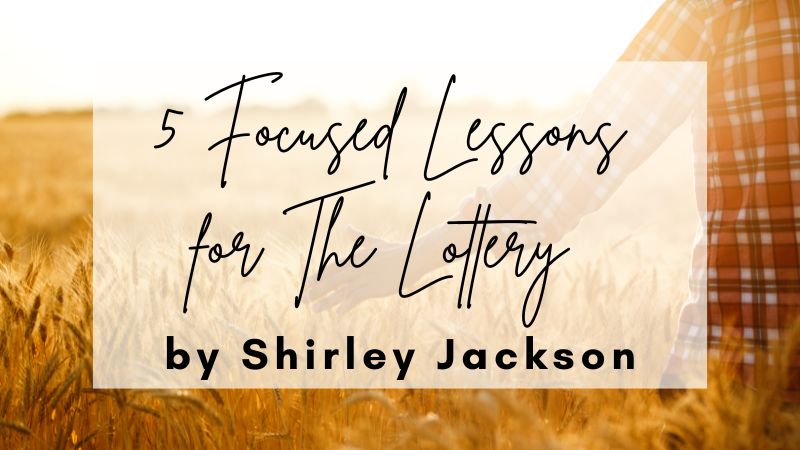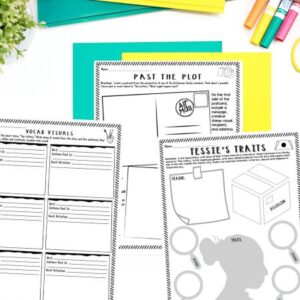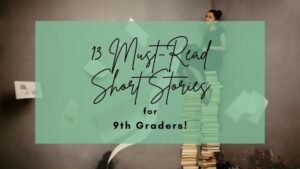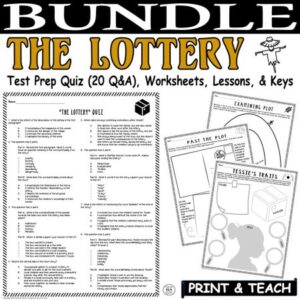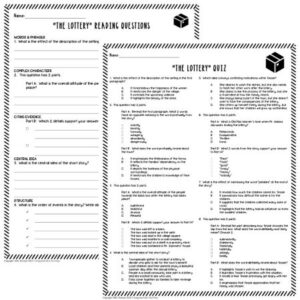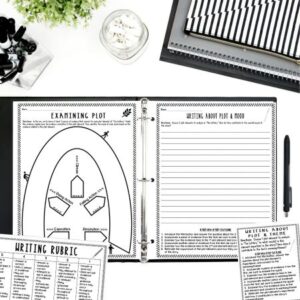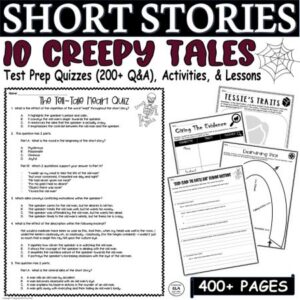I can clearly remember reading The Lottery story by Shirley Jackson in 11th grade. My English teacher, Mr. Canning, gave us zero background information, previewed nothing, and just read the story aloud to us. And I still remember the shock the whole class felt at the story’s resolution.
You know something’s off throughout the tale, but the twist ending truly makes The Lottery story by Shirley Jackson a true classic!
After I got my own high school classroom, one of the first stories I was determined to read with my students was this universal piece of literature! The gasps at the end of every class were both satisfying and nostalgic.
If you also want to teach this story purposefully and engagingly, check out the activity ideas below for help.
Keep reading for 5 Focused Lessons for The Lottery Story by Shirley Jackson!
Want help with Test Prep? Check out this FREE Pack of 3 Test Prep Activities to help students achieve success on standardized tests while reading classic lit!
5 Focused Lessons for The Lottery Story by Shirley Jackson
If you have NOT read The Lottery story by Shirley Jackson, run and read it ASAP! It is a quick read and will engage you and your students within the very first paragraph!
Questions will fly through your head:
Why are the kids gathering stones? Why is the town gathering? What is the lottery about? Can I win this lottery?
Before reading this story with your students, consider what you hope to accomplish, other than reading an awesome short story. What standards or skills do you need to teach?
I try to focus on 3-5 standards, not just one. So often, standards are taught in isolation, but how can students analyze a short story if they cannot comprehend the major elements or vocabulary of the story? How can they write about anything without evidence? How can they discuss literary devices if they cannot break down the meaning of individual words or phrases?
Do you see what I mean? There are so many ways to integrate standards and skills as you teach The Lottery story by Shirley Jackson!
We’ll start with easier activities and increase with complexity as we go on…
1. Visualize the Vocabulary
Previewing this short story by examining its higher-level vocabulary is vital! If students don’t know most of the words, how can they ever understand the meaning of the story?
Use this list or let students choose their own vocabulary words before reading:
Ex. profusely, assembled, boisterous, jovial, constructed, liberty, reprimands, surveying, conducted, paraphernalia, perfunctory, interminably, disengaged, gravely, petulantly, consulted, daintily, defiantly, etc.
LESSON OUTLINE
I DO: Choose 1 word and model what you want to see from your students.
WE DO: Let students help you locate a word, define it, and draw a visual.
YOU DO: Encourage students to work individually, in pairs, or in groups to finish their own visuals.
Directions: Write down 3+ words from the story and the sentences they are used in. Then, define and creatively visualize each word!
If you have time, share out. Allowing students to teach the word to other students boosts their confidence, which is vital to reading comprehension!
If you need more short story ideas for high school students, click below!
2. Examine Plot Elements
As you introduce the story, make sure to define or review the plot elements, so students can follow the major scenes in the story.
Exposition: the introduction to the characters, setting, and conflict; helps to set the stage for the reader
Rising Action: action that takes place after the exposition and leads up to the conflict; develops the characters and builds suspense
Climax: the most important part of the story; the highest point of action that causes a change in some way
Falling Action: action that takes place after the climax and leads to the resolution
Resolution: the end of the story that resolves the conflict, reveals a change or lack thereof in the main character, and ends with a reflection connected to the meaning of the story
LESSON OUTLINE
I DO: Read the first page of the story. Model how to examine the exposition, provide evidence, and analyze its purpose or importance.
WE DO: Read the next couple of pages of the story. Work together with your students to break down the rising action.
YOU DO: Encourage students to work individually, in pairs, or in groups to finish their plot diagrams. You can easily differentiate by asking for more evidence or delving into how the element contributes to the story’s theme.
You can use this plot diagram or have students create their own; however, emphasize the evidence for each element. Evidence is key!
3. Answer Comprehension Questions
I know. Some students may find this activity tedious or “busy” work, but incorporating critical thinking questions is super important, especially for struggling readers.
LESSON OUTLINE
I DO: Choose 1 question to answer. Ensure you model using evidence for your students and complete sentences for your response.
WE DO: Allow students to help you answer the next question. Make sure they write the answer down, so they can use it as a model later on.
YOU DO: Let students work individually, in pairs, or in groups to answer the rest of the questions.
You can spice up this type of activity in several ways:
- Divide up the questions, so students can answer them and give their “answers” to other groups.
- Have students create their own reading questions and answers for a reading quiz they can give to other classes.
- Conduct a Socratic Seminar and use the questions to guide their analysis.
- Offer a test prep quiz that students can work on in groups or in pairs for an assessment grade.
There is always a way to make questioning more relevant and palpable for our students, which is powerful as students read The Lottery story by Shirley Jackson!
4. Analyze Characterization
I absolutely LOVE teaching about characterization. We might think students should have mastered this standard in their elementary years, but I find that identifying evidence-based external and internal traits as well as following a character’s development can be a struggle for most students.
Start the lesson by teaching about evidence and characterization.
1. Citing Evidence- the process of providing support for your ideas directly from the passage.
2. Complex Characters- Explain that authors write about people and/or characters with many physical, mental, and emotional dimensions/traits; students can begin analyzing this standard by thinking about their own physical, mental, and emotional traits.
Then, move on to The Lottery story by Shirley Jackson.
LESSON OUTLINE
I DO: Model how to chart Tessie Hutchinson by annotating every action, description, narration, or dialogue related to her when she comes on the scene.
WE DO: Allow students to help you as you examine how Tessie develops over time. Make sure they are writing their ideas down, so they can use their notes as a model for later on.
YOU DO: Let students work individually, in pairs, or in groups to finish the story and their characterization analysis.
Focus on these questions:
How is she portrayed as she enters the story and how does she change by the end? What evidence supports your ideas?
Finally, visualize Tessie and her journey. What does she look like based on varied moments/scenes in the story?
Going step-by-step through these activities while reading The Lottery story by Shirley Jackson will prepare your students for higher-level analysis!
5. Write a Literary Analysis
Like the activities above for The Lottery Story by Shirley Jackson, there are easier or more challenging ways to write a literary analysis paragraph and/or essay!
If you want to start off with a simple prompt, why not analyze a single plot element and how it contributes to the mood of The Lottery story by Shirley Jackson?
Here is my simple, go-to outline to make teaching this paragraph analysis MUCH easier:
STEP-BY-STEP OUTLINE
1. Introduce the title/author and answer the question about the plot element and the mood
2. Incorporate a piece of evidence from the text; be sure to embed the quote
3. Examine how the evidence links to the plot element and connects to the mood
4. Incorporate another piece of evidence from the text; be sure to embed the quote
5. Examine how the evidence links to the plot element and connects to the mood
6. Reiterate the importance of the plot element and how it contributes to the story’s mood
In fact, you could use this teacher model and then have students write about another plot element for The Lottery story by Shirley Jackson!
LESSON OUTLINE
I DO: Model how to write an analysis paragraph for the exposition. Here is a Topic Sentence Example: The exposition of Shirley Jackson’s “The Lottery” is important to the story’s meaning because it helps to set the stage for the rest of the story and creates a puzzling, yet unnerving mood.
WE DO: Get students involved by having them locate evidence for the above topic sentence. Then, model how to embed the quotes and link to the mood!
YOU DO: Let students work individually, in pairs, or in groups to write their own literary analysis paragraphs.
You can focus on characterization, mood, plot, and/or theme! Up the ante by asking for more evidence from The Lottery story by Shirley Jackson or extending the writing length!
Why teach The Lottery story by Shirley Jackson?
Well, honestly, I cannot think of a single reason not to. Even if students have read the story before, which many have by high school, there is so much depth to it. You can dig more deeply and ask more from your upper-level students. Plus, you can teach The Lottery story by Shirley Jackson in connection to other Creepy Stories during the fall as a unit!
RESOURCE THAT INCLUDES THE LOTTERY STORY BY SHIRLEY JACKSON:
Need creepy short stories for upper middle and high school students? This 10 Scary Short Story BUNDLE includes lessons, test prep quizzes, and activities for texts like “The Most Dangerous Game,” “The Monkey’s Paw,” “The Tell-Tale Heart,” “The Veldt,” “The Lottery story by Shirley Jackson,” “The Masque of the Red Death,” “Click Clack the Rattle Bag,” “The Cask of Amontillado,” “Lamb to the Slaughter,” & “A Vendetta!”
Make teaching short stories with relevant and rigorous activities SIMPLE & EASY!
Need more fun lessons and activities that utilize The Lottery story by Shirley Jackson? Check out my store Kristin Menke-Integrated ELA Test Prep!

